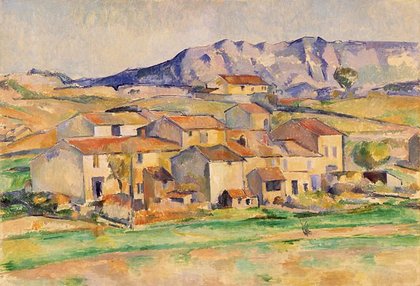|
KYSO Flash ™
Knock-Your-Socks-Off Art and Literature
|
|
|||
Paul Cézanne’s Mont Sainte-Victoire and Hamlet Near Gardanne 1886–90by Charles D. Tarlton
1 The older village houses of southern France were rectangular and seldom ornamented. Clustered together, with their pastel colored plaster walls and red-tile roofs, there were few differences among them. Farms in the American Midwest were laid out from the start on a township grid six miles by six miles, which was further divided into thirty-six one-mile “sections.” The section was further divided into the more popular 160-acre “quarter section” farms. As farmers lived on their land, they were scattered and far apart on the country roads, each responsible for their own house. Towns grew up where there were lots of farms, but the town residents were, by and large, not farmers. The French farmers always lived in the central village, a hub from which parcels of farm land radiated. It was a good deal more social.
it looks pretty much
solid geometry
the stone in the walls 2 The Mediterranean village was at the heart of Cubism; everyone painted at least one cubist village—Braque, Picasso, Matisse, Léger, Gris, Metzinger, and Le Fauconnier. The village was a single object with multiple plane surfaces, the pictorial arrangement of which depended on where you were standing (or pretending to stand). These cubists taught a lesson in “perspective”; they tore houses down and reassembled them so you could see the side and top at the same time. They saw with a fly’s eye, in all directions. It’s as if you had already walked the village streets in Cézanne’s town, and you were now remembering everything you’d seen, but remembering it all at once and remembering all the time that it was paint on a flat canvas surface.
on the Autoroute A-8
Paul Cézanne and how
nor any one place 3 Mont Sainte-Victoire was the subject of at least thirty-five Cézanne oil paintings and more watercolors than we can count. His obsession was to express the intersection of the mountain and our emotions, to capture both in a well-wrought canvas. For Cézanne, the inward thought and feeling of the artist sought their embodiment in a Nature dragged into and onto the canvas. The subjects, the mountain and the village, were brought beyond themselves, made Art by a mix of duty and will, the obligation to be true and the necessity to embody the artist. The town and the mountain were brought to the limen of abstraction; they were flattened onto the canvas and we realize that the painter has given up trying to fool our eyes.... Look at those houses! You will see them later in the landscapes of the great Cubists.
in 1967
narrow cobblestone
on the beach wedding
Publisher’s Notes:
|
|
Site contains text, proprietary computer code, |
|
| ⚡ Many thanks for taking time to report broken links to: KYSOWebmaster [at] gmail [dot] com ⚡ | |
